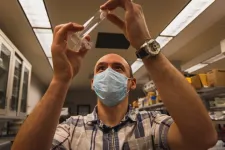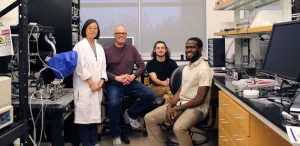(Press-News.org) Scientists at Simon Fraser University (SFU) and the Lankenau Institute for Medical Research (LIMR) near Philadelphia have found that a drug discovered at SFU and patented several years ago may have potential lifesaving results in the treatment of conditions leading to sudden cardiac death.
The drug, known as AR-787, was originally discovered and designed by former PhD student Mena Abdelsayed as a pharmacological solution for arrhythmias.
The so-called J Wave syndromes (JWS), consisting of Brugada syndrome and early repolarization syndromes, occur in about one in 2,000 people and are associated with life-threatening cardiac arrhythmias—complications with the rate or rhythm of the heart.
In some patients, these arrhythmias can lead to sudden cardiac death and, in some cases, may be triggered by hypothermia.
The first line of treatment for high-risk patients often involves the use of an implantable cardioverter defibrillator (ICD), though this route has shown to be problematic, especially for young patients and those experiencing frequent shocks from an ICD.
A recently published study led by LIMR, involving current and former SFU researchers Mena Abdelsayed, Mohamed Fouda, and SFU biomedical physiology and kinesiology professor Peter Ruben, has shed light on a possible pharmacological approach to treat arrhythmic activity in the heart caused by JWS.
The drug, known as ARumenamide-787, or AR-787 for short, was designed by Abdelsayed in an SFU laboratory led by Ruben. AR-787 has now proven to be effective in a series of lab trials at LIMR and SFU.
AR-787 was designed to directly interact with a protein in the heart called the cardiac sodium channel, which is essential for electrical impulse conduction that triggers contraction of the heart muscle.
More importantly, it interacted with the transient outward current channels in the heart, acting to suppress arrhythmic activity associated with JWS.
While he was a graduate student in Ruben’s lab, Abdelsayed (now a postdoctoral fellow at Stanford University) designed AR-787 based on his knowledge about the structure of sodium channels.
Abdelsayed designed different drug structures with computer modelling programs to select and visualize the results of his designs, adjusting them until they rendered the desired result.
Working in Ruben’s SFU lab, his research team, including Abdelsayed, Fouda, and Dr. Dana Page, proved the drug’s effectiveness in altering sodium channel current characteristics by performing tests on sodium channel genes artificially inserted into human embryonic kidney cells.
Still, they had yet to verify the drug’s effectiveness in the muscle cells of a real heart. That is when they tapped into the expertise of one of the world’s most recognized researchers in heart arrhythmia, Charles Antzelevitch, PhD, a distinguished professor emeritus and xecutive director of cardiovascular research at LIMR, which is part of the Main Line Health system outside Philadelphia.
Dr. Antzelevitch’s team—consisting of Drs. José Di Diego, Héctor Barajas-Martínez, Robert Cox, Victoria M. Robinson, and Bence Patocskai, and joined by Joseph Jung—supported the research by conducting AR-787 trials on mammalian hearts in LIMR’s laboratory.
They tested the effect of the drug on the sodium channel current as well as additional ion channels within the heart. They found that AR-787 not only augments sodium channel activity, but was effective in inhibiting a particular cardiac potassium channel that contributes importantly to the development of life-threatening arrhythmias, in experimental models of Brugada and early repolarization syndromes.
“I’ve been researching J-Wave syndromes for 35 years and have shown that inhibition of the transient outward potassium current can prevent the development of lethal arrhythmias related to JWS regardless of the genetic cause of the syndromes,” says Dr. Antzelevitch.
“Twenty-four years ago, we reported that a drug called quinidine blocks that channel and is effective in suppressing the development of JWS-related cardiac arrhythmias. Quinidine has since been used worldwide in the treatment of JWS.
“More recently, we reported that a natural product from the safflower plant, called acacetin, also blocks the transient outward potassium current. Much of our work in recent years has been focused on finding a drug with similar features but that would dissolve better than acacetin in blood, and is free of quinidine’s adverse side effects. We’re optimistic that AR-787 may be the drug we’ve been looking for.”
The team has since patented the drug and hopes that their research will inspire interest within the pharmaceutical industry to take AR-787 to the next step, by testing its long-term safety and efficacy, and eventually, conducting clinical trials. “Our hope is that this drug will save lives,” says Ruben.
SFU and LIMR are currently seeking a licensee to bring this important discovery from the bench to the bedside.
You can read the group’s published research paper and findings here.
END
Drug discovered by SFU researchers shows potential life-saving results in treating cardiac arrhythmias
2023-05-10
ELSE PRESS RELEASES FROM THIS DATE:
Social conformity in pandemics: How our behaviors spread faster than the virus itself
2023-05-10
The behaviors and actions of hypersocial species like humans are heavily influenced by the behaviors and actions of those around them. This was evidenced throughout the COVID-19 pandemic; protective measures such as masking and social distancing varied widely as these behaviors were affected by where people were and who they were around, which in turn affected disease prevalence and transmission rates.
Now, researchers from the School of Arts & Science at the University of Pennsylvania and Queen’s University in Canada have produced a theoretical model for disease ...
Study proves efficacy of remote physical training in rehabilitation of severe COVID patients
2023-05-10
Researchers at the University of São Paulo (USP) in Brazil have created an exercise training program that survivors of severe COVID-19 can safely perform at home as rehabilitation therapy for persistent symptoms after they are discharged from hospital. Findings of a study recently reported in the British Journal of Sports Medicine show that exercise can improve the quality of life for these patients, benefitting their health and functionality while reducing the number of persistent symptoms, such as muscle pain and weakness.
Long COVID (also known as post-COVID-19 syndrome) affects more than 40% of people who ...
17 percent of U.S. households face growing water affordability challenge
2023-05-10
DURHAM, N.C. – In 787 communities served by the United States’ largest utilities, 17 percent of households struggle to afford basic water services, according to a new analysis by researchers at Duke University.
Nearly half the U.S. population lives in the communities covered by the analysis, which was published May 10 in the open-access journal PLOS Water. The analysis shows that 28.3 million people in those communities live in households that spend more than one day each month working to pay for water ...
Protein nanoparticle vaccine with adjuvant improves immune response against influenza, biomedical sciences researchers find
2023-05-10
ATLANTA—A novel type of protein nanoparticle vaccine formulation containing influenza proteins and adjuvant to boost immune responses has provided complete protection against influenza viral challenges, according to a new study published by researchers in the Institute for Biomedical Sciences at Georgia State University.
The findings published in the journal Small describe a promising influenza vaccine candidate that uses adjuvants, substances that increase immune response to a vaccine, to boost effectiveness against ...
Songs of the oceans raise environmental awareness #ASA184
2023-05-10
CHICAGO, May 10, 2023 – For many people, there are few sounds as relaxing as ocean waves. But the sound of the seas can also convey deeper emotions and raise awareness about pollution.
At the upcoming 184th Meeting of the Acoustical Society of America, Colin Malloy of Ocean Network Canada will present his method to transform ocean data into captivating, solo percussion songs. The talk, “Sonification of ocean data in art-science,” will take place Wednesday, May 10, at 3:25 p.m. in the Indiana/Iowa room. The meeting will run May 8-12 at the Chicago Marriott Downtown Magnificent Mile Hotel.
To construct his compositions, Malloy employs sound from ...
Sleep apnea, lack of deep sleep linked to worse brain health
2023-05-10
EMBARGOED FOR RELEASE UNTIL 4 P.M. ET, WEDNESDAY, MAY 10, 2023
MINNEAPOLIS – People who have sleep apnea and spend less time in deep sleep may be more likely to have brain biomarkers that have been linked to an increased risk of stroke, Alzheimer’s disease and cognitive decline, according to new research published in the May 10, 2023, online issue of Neurology®, the medical journal of the American Academy of Neurology. The study does not prove that these sleep disturbances cause the changes ...
Virginia Tech researchers conduct proof-of-concept study on mosquito’s scent preferences
2023-05-10
Humans smell. Each and every person has a unique body odor.
People have been using commercial products to alter their scent for generations. From soaps to perfumes, people gravitate to floral and fruity smells.
Whether we think these smells are good or bad is of little consequence to mosquitoes, transmitters of diseases that kill hundreds of thousands of people each year. Additionally, mosquitoes rely on plant nectar to get some sugars needed to sustain their metabolism in addition to needing nutrients in the blood to produce eggs.
And humans with nutrients and a floral scent? That’s two strikes.
In spite of these scents being right under humans’ noses, the impact of ...
Older adults are more easily distracted, study reports
2023-05-10
RIVERSIDE, Calif. -- While engaged in a physical task requiring effort, such as driving a car or carrying grocery bags, older adults are more likely than younger adults to be distracted by items irrelevant to the task at hand, a University of California, Riverside, study reports.
The study assessed the interaction between physical exertion and short-term memory performance when distractors were present or absent in younger and older adults.
“Action and cognition, which interact often in daily life, are sensitive to the effects of aging,” said graduate student Lilian Azer, the first author of the research paper published ...
Texas A&M Institute for Advancing Health through Agriculture seeks experts to support study on responsive agriculture
2023-05-10
College Station, Texas (May 10, 2023) – Texas A&M’s Institute for Advancing Health Through Agriculture (IHA) is spearheading a study that focuses on advancing the concept of responsive agriculture and is seeking experts and leaders in the agriculture-food value chain to serve one of its three committees. The committees, along with a recently named Task Force, will help develop a road map to achieve responsive agriculture, an agricultural system and food environment that supports health ...
How does the brain interpret taste?
2023-05-10
NORMAN, OKLA. – Taste is a complex neurological experience that has the potential to provide extensive, and perhaps surprising, information on how the brain makes sense of sensations and the organization of brain pathways. A research project funded by the National Institutes of Health, led by Christian H. Lemon, Ph.D., an associate professor in the Department of Biology in the Dodge Family College of Arts and Sciences, aims to better understand how the brain processes taste and how those neural pathways can evolve.
Taste ...





